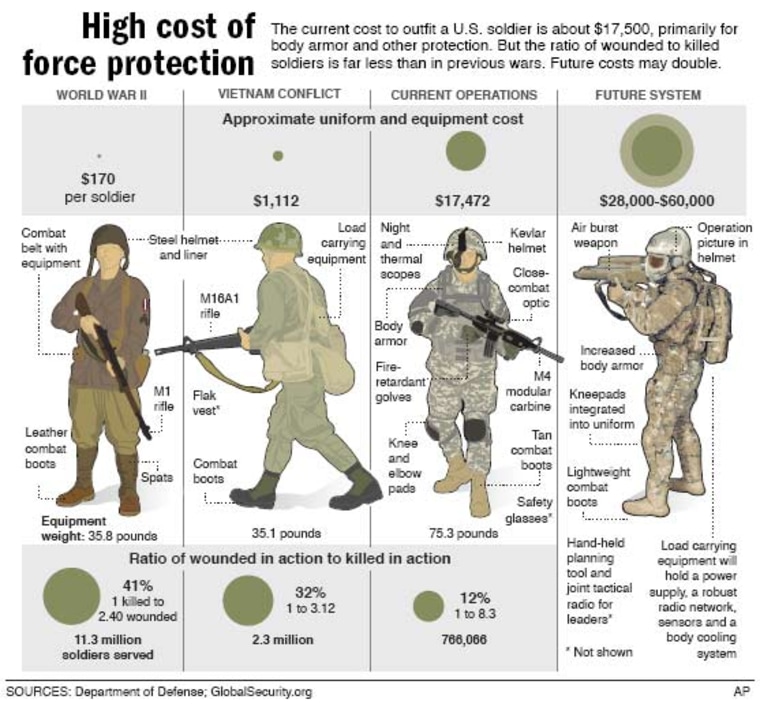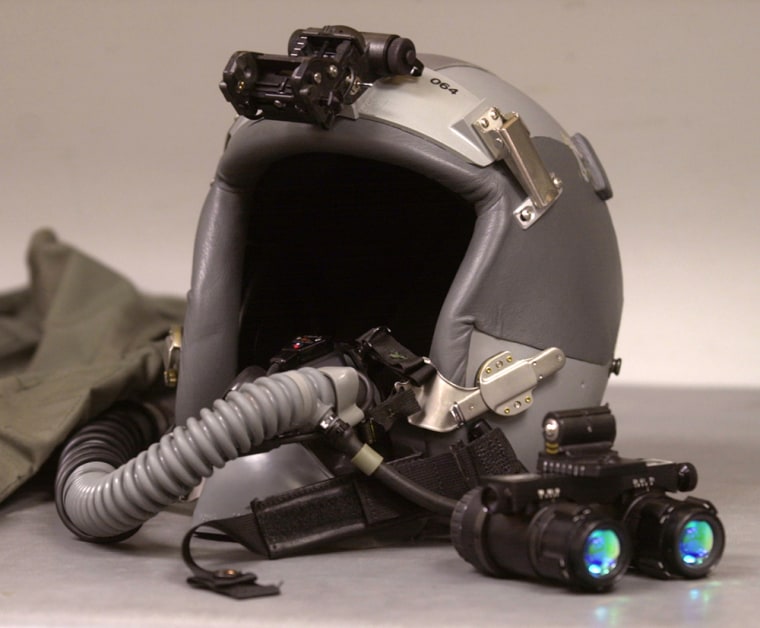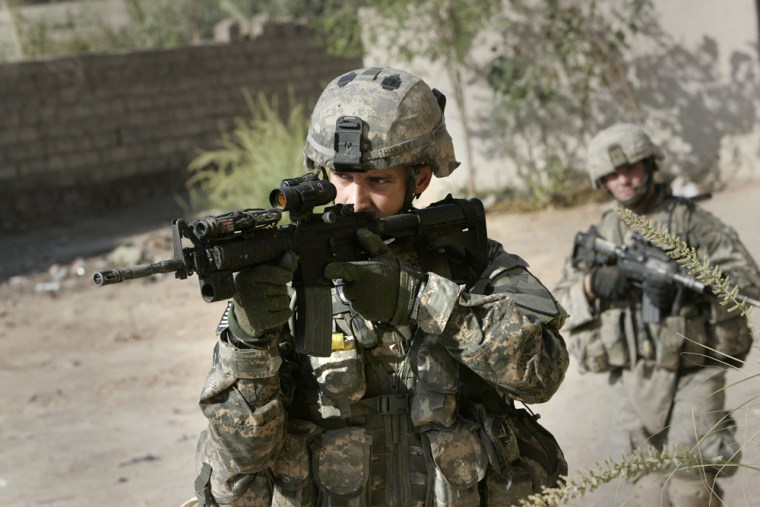As Washington lawmakers argue over the spiraling price of the war in Iraq, consider this: Outfitting a soldier for battle costs a hundred times more now than it did in World War II.
The cost was $170 in 2006 inflation-adjusted dollars then, about $17,500 now and could be an estimated $28,000 to $60,000 by the middle of the next decade.
“The ground soldier was perceived to be a relatively inexpensive instrument of war” in the past, said Brig. Gen. Mark Brown, head of the Army agency for developing and fielding soldier equipment.
Now, the Pentagon spends tens of billions of dollars annually to protect troops and make them more lethal on the battlefield.
In the 1940s, a GI went to war with little more than a uniform, weapon, helmet, bedroll and canteen. He carried some 35 pounds of gear that cost $170, according to Army figures.
That rose to about $1,100 by the 1970s as the military added a flak vest, new weapons and other equipment during the Vietnam War.
Today, troops in Iraq and Afghanistan are outfitted with advanced armor and other protection, including high-tech vests, anti-ballistic eyewear, earplugs and fire-retardant gloves. Night-vision eyewear, thermal weapons sights and other gear makes them more deadly to the adversary.
In all, soldiers today each are packing more than 80 items — weighing about 75 pounds — from socks to disposable handcuffs to a strap cutter for slashing open a seatbelt if they have to flee a burning vehicle.
Newer gear around corner
Several items were added since 2002, when troops in Afghanistan complained that their equipment was outdated and not best suited to the new campaign.
Still, newer gear is just around the corner.
Between 2012 and 2014, officials want troops to have head-to-toe protection, a weapon that can shoot around corners so soldiers don’t have to expose themselves to their enemy and a helmet-mounted 1.5-inch computer screen showing maps of the battlefield.
Drawings of the gear — some parts already in prototype and in the field — look like futuristic “Master Chief,” the human über-soldier who battles aliens in the popular sci-fi video game Halo. Researchers prefer to call it “the F-16-on-legs concept,” a nod to U.S. fighter jets.
The wide range in price — an estimated $28,000 to $60,000 a person — is partly because not all troops will have all of the equipment. Some of it, such as a planning tool, is only for unit leaders.
The ensemble makes the soldier a highly protected “walking computer hub” who can send out and take in information such as maps showing where all friendly and enemy forces are arrayed, said Dutch DeGay, equipment specialist at the Army’s research and development center in Natick, Mass.
“Your tax dollars at work,” he said.

Cost may reflect U.S. values
Indeed, spending on ever-improving and ever-more-costly technology to make troops safer and more effective could be seen as just what taxpayers wanted.
It reflects an American society that values human life and has a distaste for too many casualties, said Dakota Wood, a retired Marine now with the Center for Strategic and Budgetary Assessments.
The increases also coincided with the development of the all-volunteer military that Americans greatly prefer over conscription. The end of the draft in the 1970s has meant fewer people in the armed forces, and those fewer people need better equipment to do more.
The military also must protect troops because of the higher investment made to recruit and train a professional force, said P.J. Crowley, a 26-year veteran of the Air Force now with the Center for American Progress.
It doesn’t help attract recruits if the military uses soldiers “as cannon fodder,” Wood said.
Over the years more spending has meant a better chance of survival. Today, for every eight soldiers wounded, roughly one dies, compared with one for every 2.4 wounded in World War II and one for every three in Vietnam, the Army says. The better odds also are due to better medical treatment and other advances.
Troops still vulnerable
Still, troops remain vulnerable and success is far from guaranteed.
Homemade insurgent bombs are the No. 1 killer of Americans in Iraq and a weapon being used increasingly in Afghanistan as well. Insurgents have been known to detonate the explosives with cell phones, washing machine timers and remote controls from toy cars.

“As we know in Iraq, a high-tech military can be vulnerable to a low-tech adversary,” Crowley said.
Of the $190 billion the Pentagon has requested for the wars in Iraq and Afghanistan in fiscal year 2008, the biggest expenses are about $77 billion for operations, about $47 billion to repair and replace destroyed equipment, and more than $30 billion for “force protection.”
More than half of the protection funds are to send 15,000 mine-resistant vehicles to Iraq — at $1 million each. The rest is for protection gear as well as activities such as destroying weapons caches scattered around Iraq by the thousands, funding an advisory group to study and recommend ways to defeat homemade bombs and operating unmanned aircraft systems that do border surveillance, help protect convoys and provide other support to troops.
